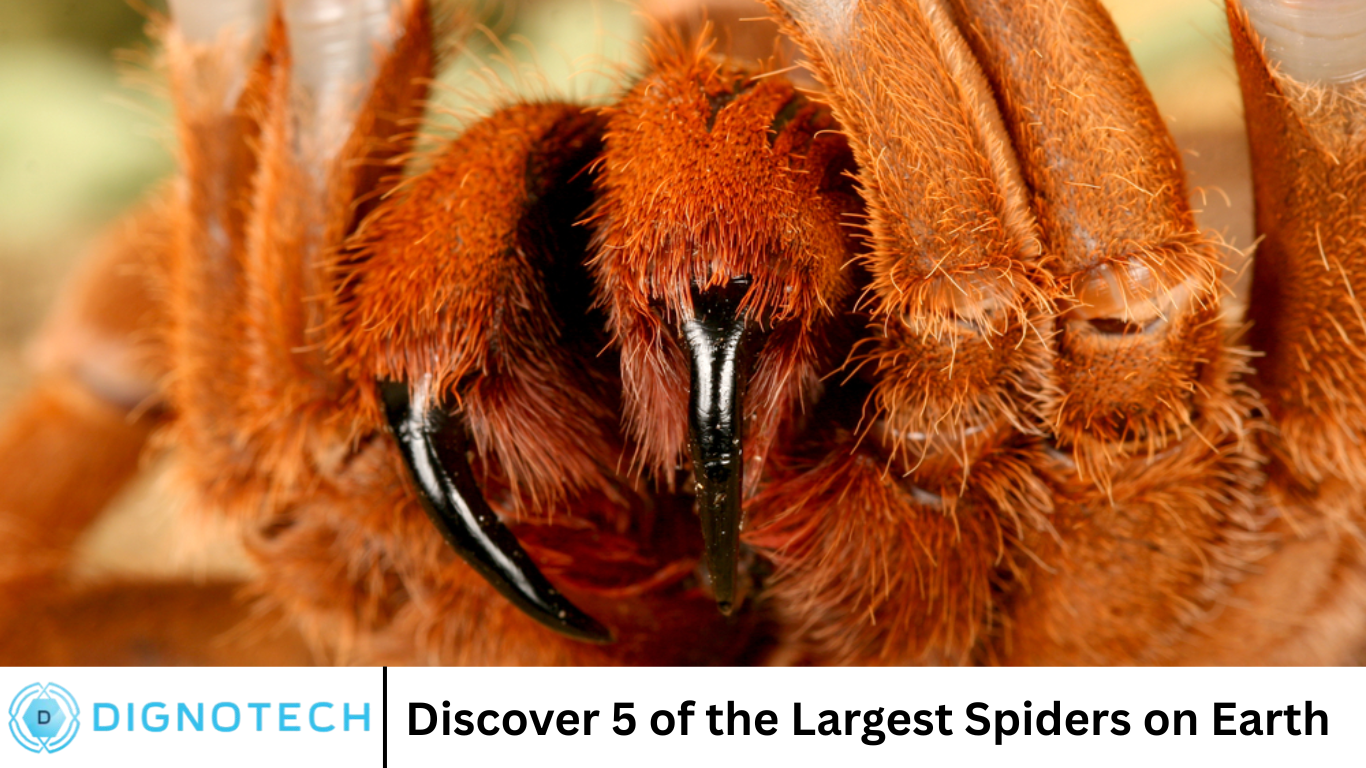Discover 5 of the Largest Spiders on Earth

Hi everyone! How are you all doing? Welcome to dignotech.com! Spiders, often misunderstood and feared, are among the most fascinating creatures in the animal kingdom. From their intricate webs to their predatory skills, spiders play a crucial role in maintaining ecological balance. While many people shudder at the thought of these eight-legged creatures, there’s no denying the awe they inspire, particularly the largest among them. Giant spiders have captured the imaginations of people worldwide, often appearing in horror films and folklore. But beyond the myths and legends, the largest spiders on Earth are real, and they are truly a marvel of nature.
In this article, we’ll explore five of the largest spiders on Earth, diving into their unique characteristics, behavior, and how they survive in their natural environments. Whether you’re a spider enthusiast or simply curious, you’ll learn more about these incredible arachnids and why they deserve respect, not fear.
Goliath Bird-Eating Spider (Theraphosa blondi)
When people talk about the largest spider in the world, the Goliath Bird-Eating Spider (Theraphosa blondi) is usually at the top of the list. This enormous tarantula, native to the rainforests of South America, particularly in regions like Brazil, Venezuela, and Guyana, holds the title of the largest spider by mass and leg span.
Size and Weight:
- The Goliath Bird-Eating Spider can reach a leg span of up to 12 inches (30 cm) or more, making it the largest spider by leg span.
- These spiders can weigh around 6 to 7 ounces (170 to 200 grams), which is roughly the size of a small bird.
Habitat and Diet: Despite its name, the Goliath Bird-Eating Spider does not typically eat birds. In the wild, it hunts a variety of prey, including insects, frogs, and small reptiles. It is a ground-dwelling species and is known for its burrows, which it uses as a retreat from predators and a place to lay eggs. The Goliath Bird-Eating Spider’s diet may occasionally include small vertebrates, but birds are not a regular part of its menu.
Behavior and Venom: This spider is known for its intimidating size and defensive behavior. When threatened, it will rub its abdomen with specialized hairs, producing a hissing sound. These spiders are also capable of releasing these hairs to irritate the skin of potential threats. While the venom of a Goliath Bird-Eating Spider is not lethal to humans, it can cause significant pain, swelling, and irritation.
Huntsman Spider (Sparassidae Family)
The Huntsman Spider, part of the Sparassidae family, is known for its impressive size and speed. While not as heavy as the Goliath Bird-Eating Spider, the Huntsman Spider is famous for its long, spindly legs and rapid movements. It is found in various parts of the world, including Australia, Africa, and Asia, with some species even making their way into human homes.
Size and Weight:
- Huntsman Spiders can have a leg span of up to 12 inches (30 cm), though the average leg span is generally a bit smaller.
- While not as heavy as the Goliath Bird-Eating Spider, Huntsman Spiders are still quite large and imposing in appearance.
Habitat and Diet: Huntsman Spiders are commonly found in trees, under rocks, and in crevices, where they can easily hunt for their prey. Unlike many other spiders that spin webs, Huntsman Spiders are known for hunting down their prey. They are fast and agile, and their primary diet consists of insects and other small invertebrates. They can even catch larger animals like lizards and small birds if the opportunity arises.
Behavior and Venom: Huntsman Spiders are typically non-aggressive toward humans and will usually flee when threatened. However, they can deliver a painful bite if provoked. Their venom is not considered dangerous to humans, though it may cause localized pain and swelling. What makes the Huntsman Spider particularly terrifying for many people is its incredible speed and its tendency to hide in dark, hard-to-reach places.
Brazilian Wandering Spider (Phoneutria)
The Brazilian Wandering Spider (Phoneutria) is another spider that stands out for both its size and its dangerous reputation. Known for its potent venom, this spider is considered one of the most venomous in the world, earning it the nickname “armed spider” due to its aggression and potency.
Size and Weight:
- While not as large as the Goliath Bird-Eating Spider or Huntsman, the Brazilian Wandering Spider has a leg span of around 6 inches (15 cm).
- It is relatively lightweight compared to other large spiders, but its venomous bite makes it a significant threat.
Habitat and Diet: The Brazilian Wandering Spider is found throughout South and Central America, primarily in tropical rainforests. Unlike most spiders, the Brazilian Wandering Spider does not build a web. Instead, it is a “wandering” spider, hunting and foraging on the forest floor at night. Its diet consists of small vertebrates, insects, and even other spiders.
Behavior and Venom: The Brazilian Wandering Spider’s venom is incredibly toxic, capable of causing paralysis, respiratory failure, and even death in severe cases. Fortunately, antivenom is available, and fatalities are rare due to timely medical intervention. These spiders are aggressive and will bite in self-defense if they feel threatened. A bite from a Brazilian Wandering Spider is considered a medical emergency.
Giant Huntsman Spider (Heteropoda maxima)
The Giant Huntsman Spider (Heteropoda maxima) is another contender for the title of the largest spider in the world. This species, found in caves in Laos, has earned a reputation due to its extraordinary leg span.
Size and Weight:
- The Giant Huntsman Spider boasts a leg span of up to 12 inches (30 cm), making it one of the largest in the Huntsman family.
- This spider is very light in weight, but its leg span and overall size make it an impressive specimen.
Habitat and Diet: The Giant Huntsman Spider is unique in that it is primarily found in caves in Laos, where it hunts in the dark, often on cave walls. Like other huntsman species, it does not spin webs but instead hunts for its prey, which consists of insects and other small animals.
Behavior and Venom: The Giant Huntsman Spider is not known for being particularly aggressive toward humans, but like other members of the Huntsman family, it will bite if provoked. Its venom is not harmful to humans, but it can cause pain and swelling. Its speed and ability to navigate in dark environments make it a particularly fearsome hunter.
The Woolly Spider (Acanthoscurria geniculata)
The Woolly Spider, or the Brazilian White Knee Tarantula (Acanthoscurria geniculata), is another large tarantula species from South America. Known for its striking appearance and considerable size, this spider is often sought after by arachnid enthusiasts.
Size and Weight:
- The Woolly Spider can reach a leg span of about 7-8 inches (18-20 cm), making it one of the larger tarantulas.
- Its weight is generally lighter than the Goliath Bird-Eating Spider, but it’s still imposing for a tarantula.
Habitat and Diet: Native to Brazil, the Woolly Spider lives in tropical rainforests and is often found in burrows or under rocks and fallen trees. Its diet consists mainly of insects, small mammals, and amphibians. These spiders are particularly good at hunting ground-dwelling creatures, and they are also known to be quite active during the night.
Behavior and Venom: The Woolly Spider is known for its defensive nature. When threatened, it may kick its urticating hairs to irritate the skin of potential threats. Its venom is not particularly dangerous to humans, though a bite can cause localized pain and swelling. Despite its intimidating appearance, the Woolly Spider is not as aggressive as some of the other spiders on this list.
Frequently Asked Question
What is the largest spider in the world?
The Goliath Bird-Eating Spider (Theraphosa blondi) holds the title of the largest spider in the world by mass and leg span, with a leg span of up to 12 inches (30 cm).
Are giant spiders dangerous to humans?
While large spiders like the Goliath Bird-Eating Spider and Huntsman Spiders can bite, they are generally not deadly to humans. The venom of these spiders is usually not potent enough to cause fatalities, though bites can cause pain, swelling, and irritation.
Where can I find the biggest spiders?
The largest spiders are primarily found in tropical and subtropical regions. The Goliath Bird-Eating Spider is found in South America, while the Huntsman and Giant Huntsman Spiders can be found in Australia and Southeast Asia.
What do the largest spiders eat?
Most large spiders are carnivorous and eat insects, small reptiles, amphibians, and sometimes small mammals. The Goliath Bird-Eating Spider is known to occasionally eat small vertebrates, but birds are not typically part of its diet.
How fast are the largest spiders?
The Huntsman Spider is known for its incredible speed, able to sprint across the ground or walls with impressive agility. The Giant Huntsman Spider, in particular, is fast enough to catch prey and avoid predators effectively.
Can giant spiders fly or jump?
While large spiders like the Goliath Bird-Eating Spider do not fly, some, such as the Huntsman Spider, are capable of jumping short distances, which they use to catch prey or escape danger.
Are these spiders kept as pets?
Some large spiders, such as the Brazilian White Knee Tarantula (Woolly Spider), are kept as exotic pets by arachnid enthusiasts. However, due to their size and specialized care needs, they require experienced owners.
Conclusion
The largest spiders on Earth are truly remarkable creatures, combining extraordinary size with fascinating survival strategies. From the Goliath Bird-Eating Spider to the Huntsman Spider, these arachnids demonstrate the incredible diversity and adaptability of the natural world. Whether you find them terrifying or awe-inspiring, these spiders play an important role in their ecosystems and are worth learning about and respecting.




